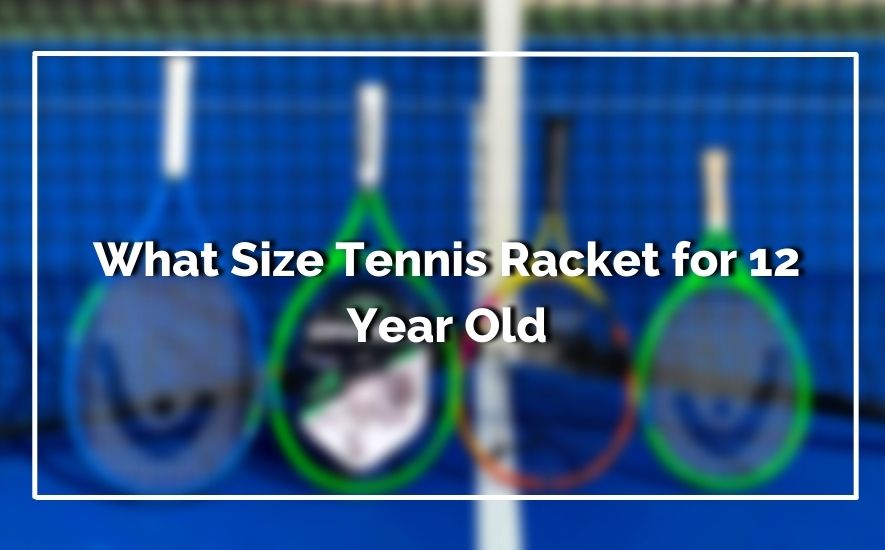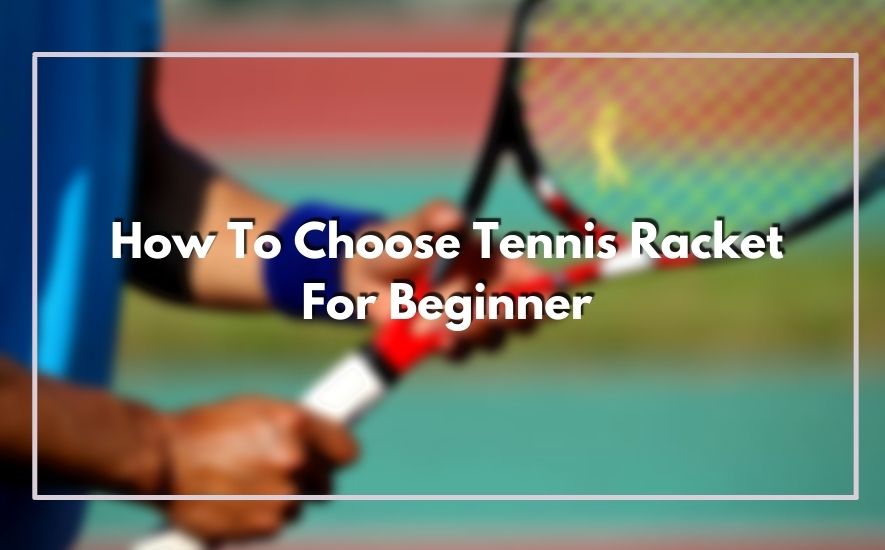Selecting the right size tennis racket for a 12-year-old can significantly impact their game and overall experience on the court. As young players continue to develop their skills and coordination, having a racket that suits their age and physical attributes is crucial. A properly sized racket not only helps prevent injuries but also enhances their ability to hit accurate shots and maintain control during matches.
What Size Tennis Racket for 12 Year Old? For a 12-year-old, the recommended tennis racket size would generally fall between 25 to 26 inches in length. This size offers a balance between maneuverability and power, catering to the developing strength and skills of young players.
With the diverse range of racket sizes available in the market, finding the ideal one can seem overwhelming. However, by considering factors such as the child’s height, arm length, and playing style, you can make an informed decision that will positively influence their tennis journey.
Table of Contents
Choosing the Right Tennis Racket Size for a 12-Year-Old
Tennis, a sport loved by many, requires the right equipment for optimal performance and enjoyment. Selecting the appropriate tennis racket size for a 12-year-old is crucial to ensure a comfortable and effective playing experience.
1. Player’s Height and Reach
One of the primary considerations in selecting a tennis racket size is the player’s height and reach. A 12-year-old’s height can vary significantly, so it’s important to choose a racket that allows them to comfortably reach the ball and execute shots with proper technique.
A general guideline is to have the child stand upright and hold the racket by their side – the ideal racket length should reach just below their wrist.
2. Racket Grip Size
Equally important is the grip size of the racket. A grip that is too large or too small can lead to discomfort and hinder the player’s ability to control the racket effectively.
To determine the appropriate grip size, have the child hold the racket in their dominant hand. There should be enough space between the tips of their fingers and the palm to slide a finger in comfortably. A comfortable grip size ensures better control and maneuverability.
3. Consider Frame Weight
The weight of the racket frame plays a significant role in a young player’s ability to handle the racket and generate power. A lighter racket is easier to maneuver and is generally recommended for beginners and younger players.
It allows for quicker swings and reduces the risk of fatigue during longer matches. Aim for a racket weight that the child can comfortably swing while maintaining proper form.
4. Balance and Swing Style
The balance of a tennis racket refers to the distribution of weight along the length of the racket. Rackets can be head-heavy, head-light, or evenly balanced. A head-heavy racket offers more power, while a head-light racket provides greater control. Consider the child’s playing style – if they are just starting, a balanced racket might be a good choice. As their skills develop, they can experiment with different balance points.
5. Seek Expert Advice
Selecting the right tennis racket size for a 12-year-old can be overwhelming, especially for those new to the sport. Seeking advice from tennis coaches, sports equipment professionals, or even experienced players can provide valuable insights. These experts can evaluate the child’s playing style, physical attributes, and preferences to recommend a racket size that aligns with their needs and goals.
Choosing the Best Tennis Racket Grip Size for a 12-Year-Old
When it comes to nurturing a young tennis enthusiast’s potential, selecting the right equipment plays a crucial role in their development. One significant factor often overlooked is the tennis racket grip size. Tailoring the grip size to a 12-year-old’s hand not only ensures comfort during play but also promotes proper technique and injury prevention.
Importance of Proper Grip Size:
The grip size of a tennis racket directly impacts a young player’s performance and overall experience on the court. An ill-fitting grip can lead to discomfort, reduced control, and even potential injuries due to strain.
A grip that’s too small may lead to excessive wrist movement, while an oversized grip can hinder maneuverability and cause tension in the arm. It’s essential to strike a balance that promotes optimal grip strength and flexibility.
Measuring for the Perfect Fit:
Determining the correct grip size involves a simple yet crucial measurement. To find the right fit for a 12-year-old, measure the distance between the tip of their ring finger and the middle crease of their palm.
This measurement provides a baseline grip size, typically ranging from 4 to 4 3/8 inches for most junior players. Keep in mind that children grow rapidly, so occasional reevaluation is advisable to ensure continued comfort and suitability.
Comfort and Technique:
Comfortable grip size is essential for a young player to develop proper technique and form. A grip that’s too large may hinder their ability to maintain a firm yet flexible hold on the racket, making it difficult to execute strokes accurately.
Conversely, a grip that’s too small may lead to overcompensation in grip pressure, potentially causing strain. A well-fitted grip encourages a more natural and fluid playing style, enabling them to learn and progress effectively.
Testing and Adjustments:
Practical testing is a valuable step in finalizing the optimal grip size for a 12-year-old. Encourage the young player to handle rackets with different grip sizes and pay attention to how each feels during swings and strokes. Their feedback, along with observations of their play, can guide you in making informed adjustments. Remember, personal preference also plays a role, so prioritize the size that promotes both comfort and control.
Consulting Experts and Professionals:
While understanding the technicalities is essential, seeking advice from tennis coaches, instructors, or experienced players can provide valuable insights. These experts can offer personalized recommendations based on a child’s playing style, skill level, and physical development. Their expertise can help fine-tune the decision-making process, ensuring that the selected grip size aligns with the young player’s goals and potential.
Upgrading Your 12-Year-Old’s Tennis Racket for Skill Development
In the exciting journey of nurturing your child’s passion for tennis, upgrading their tennis racket plays a pivotal role in enhancing skill development and overall performance on the court. As young players continue to grow and improve, their equipment needs to evolve alongside their skills.
Understanding the Growth Phase:
At the age of 12, children experience significant physical growth and skill refinement. Their motor skills, strength, and coordination are developing rapidly.
Upgrading the tennis racket at this stage is crucial to ensure that the racket’s weight, grip size, and length are appropriate for their current physical capabilities. A properly fitted racket minimizes the risk of injury and allows for smoother, more controlled swings.
Importance of Racket Technology:
Advancements in tennis racket technology have led to improved materials and design elements that can significantly impact a player’s performance. Rackets with larger sweet spots offer more forgiveness on off-center hits, boosting your child’s confidence and shot consistency.
Additionally, modern rackets often incorporate vibration dampening technology, reducing the impact on young arms and wrists during aggressive shots.
Tailoring the Racket to Playing Style:
As your child hones their tennis skills, their playing style and preferences may become more apparent. Some players develop a preference for powerful baseline shots, while others may lean towards a more versatile, all-court approach. Upgrading the racket allows you to choose a model that complements their playing style, aiding in shot execution and strategic gameplay.
Professional Guidance and Testing:
Consulting with a professional coach or a knowledgeable tennis equipment specialist can be immensely beneficial when selecting a new racket. They can evaluate your child’s playing style, strengths, and areas for improvement, helping you make an informed decision. Additionally, many sports stores offer racket testing programs, allowing young players to try out different rackets before making a final choice.
Transition and Adaptation:
Introducing a new racket requires a period of adjustment. Encourage your child to gradually transition from their old racket to the upgraded one. Start with practice sessions to build familiarity and comfort. Over time, they’ll adapt to the new racket’s feel and characteristics, unlocking its full potential and capitalizing on their skill development.
Junior Tennis Accessories for 12-Year-Old’s
Tennis is a fantastic sport for young athletes, fostering physical fitness, mental agility, and sportsmanship. To ensure that your 12-year-old tennis enthusiast is equipped for success on the court, it’s crucial to invest in the right junior tennis accessories. These age-appropriate essentials enhance their playing experience and help them develop their skills further.
1. Racquets Tailored to Junior Players:
Selecting the right tennis racquet is paramount for a 12-year-old’s game. Opt for a junior-sized racquet with a suitable grip size and weight, promoting better control and maneuverability. The racquet’s length should cater to their height, allowing them to swing comfortably.
Cutting-edge racquet technologies, such as lightweight frames and vibration dampening, can reduce strain and enhance performance, ensuring your young player stays focused and confident on the court.
2. Appropriate Footwear for Court Traction:
Tennis is a sport that demands quick movements and sudden changes in direction. The right tennis shoes offer the necessary traction and stability to prevent slips and ensure your child’s safety.
Look for well-cushioned shoes with non-marking outsoles, designed specifically for tennis courts. Breathable materials and ankle support features can contribute to comfort during long matches and rigorous training sessions.
3. Comfortable and Performance-Enhancing Apparel:
Outfit your young player with comfortable tennis apparel that allows a full range of motion while maintaining a stylish look. Moisture-wicking fabric technology keeps them cool and dry, even during intense rallies. Choose from a variety of colors and designs to make their tennis experience both functional and enjoyable. Integrated sun protection features are a plus, guarding against harmful UV rays during outdoor matches.
4. Tennis Bags for Organized Gear Management:
Efficiently organizing and transporting tennis gear is a must for any young athlete. A junior-specific tennis bag offers multiple compartments for racquets, tennis balls, water bottles, and personal items.
Some bags even come with thermal insulation, ensuring tennis balls maintain optimal bounce. With adjustable straps for easy carrying, these bags promote independence and responsibility in keeping track of their equipment.
5. Sweatbands and Grip Aids for Enhanced Performance:
Tennis can be physically demanding, making sweatbands an essential accessory to keep hands and eyes clear during intense play. Furthermore, grip aids like overgrips or grip enhancers provide a confident hold on the racquet, preventing slips and ensuring accurate shots. These small but impactful accessories contribute to maintaining focus and precision throughout matches.
Extending the Lifespan of a 12-Year-Old’s Tennis Racket
Tennis is an exhilarating sport that not only encourages physical activity but also teaches valuable life skills. For a young enthusiast with a 12-year-old tennis racket, maximizing its lifespan becomes crucial to continue enjoying the game without unnecessary replacements.
1. Proper Storage and Protection:
Storing the tennis racket correctly when not in use significantly contributes to its durability. Invest in a quality racket cover or sleeve to shield it from dust, moisture, and any accidental impacts. Placing the racket in a cool, dry place away from direct sunlight prevents warping and deterioration of the strings and grip.
2. Regular Cleaning and Maintenance:
Regular cleaning after each game is essential. Use a damp cloth to wipe off dirt, sweat, and any debris from the racket’s frame and strings. This prevents the buildup of grime that can affect performance. Inspect the grip for signs of wear and replace it if necessary, ensuring a comfortable and secure hold during play.
3. String Care and Tension:
The racket’s strings play a pivotal role in its performance. To extend their lifespan, avoid over-tensioning them. While tighter strings might provide more power, they are more prone to breaking. Opt for a middle-ground tension that suits the player’s style and skill level. Regularly check for frayed or damaged strings, as playing with compromised strings can lead to further damage and decrease the racket’s lifespan.
4. Appropriate Playing Surfaces:
The type of court surface greatly affects the wear and tear on the racket. If possible, avoid playing on abrasive surfaces like concrete, as they can cause premature degradation of the racket’s frame and strings. Opt for clay or grass courts, which are gentler on the racket. If playing on hard courts is inevitable, consider using shock-absorbing accessories to minimize the impact on the racket.
5. Professional Check-ups:
Just like a car needs regular servicing, a tennis racket can benefit from professional inspection. Taking the racket to a skilled stringer or technician can help identify any underlying issues, such as frame cracks or structural damage, that might not be apparent to the untrained eye. Addressing these problems promptly can prevent further deterioration and potentially save the racket.
Conclusion
In the delightful game of tennis, choosing the right racket size for your 12-year-old prodigy is akin to finding the perfect melody for a musical composition. Just as a maestro orchestrates a symphony, a thoughtful selection of racket size harmonizes with a child’s developing skills and physique. So, as you embark on this racket quest, envision a painter selecting the precise brushstroke to create a masterpiece.
A racket that aligns with your young athlete’s age, height, and skill level becomes the very brush that paints the canvas of their tennis journey. Remember, in this sporting symphony, the right racket size is the virtuoso’s key to crafting a future full of aces and smashes!



